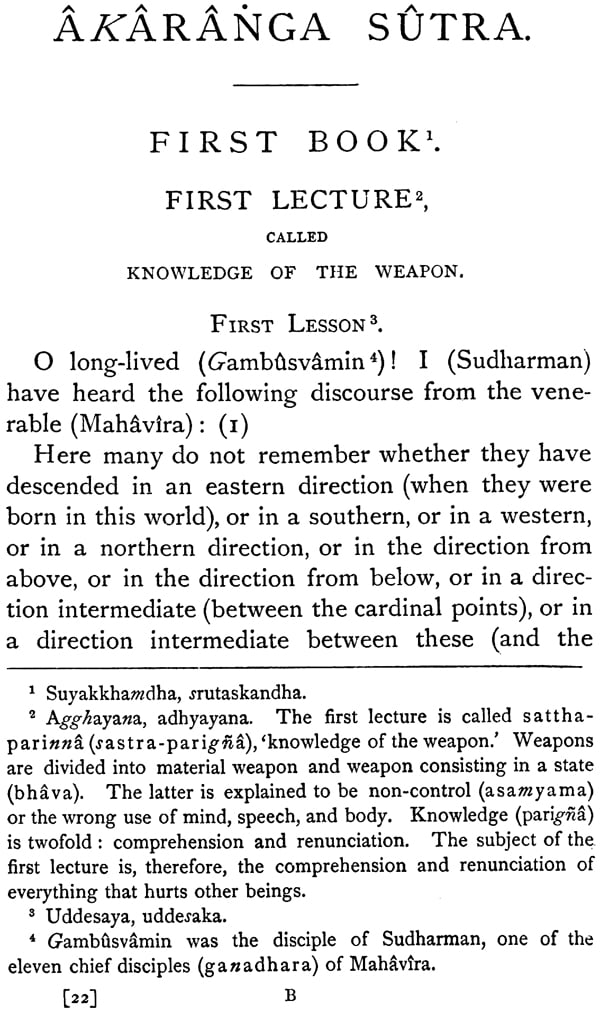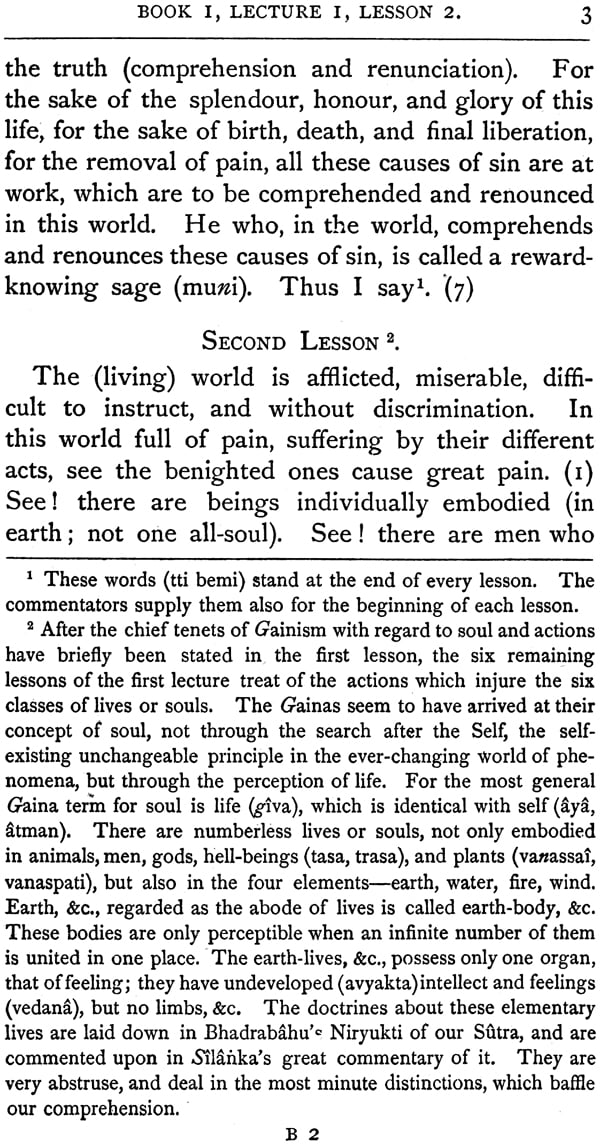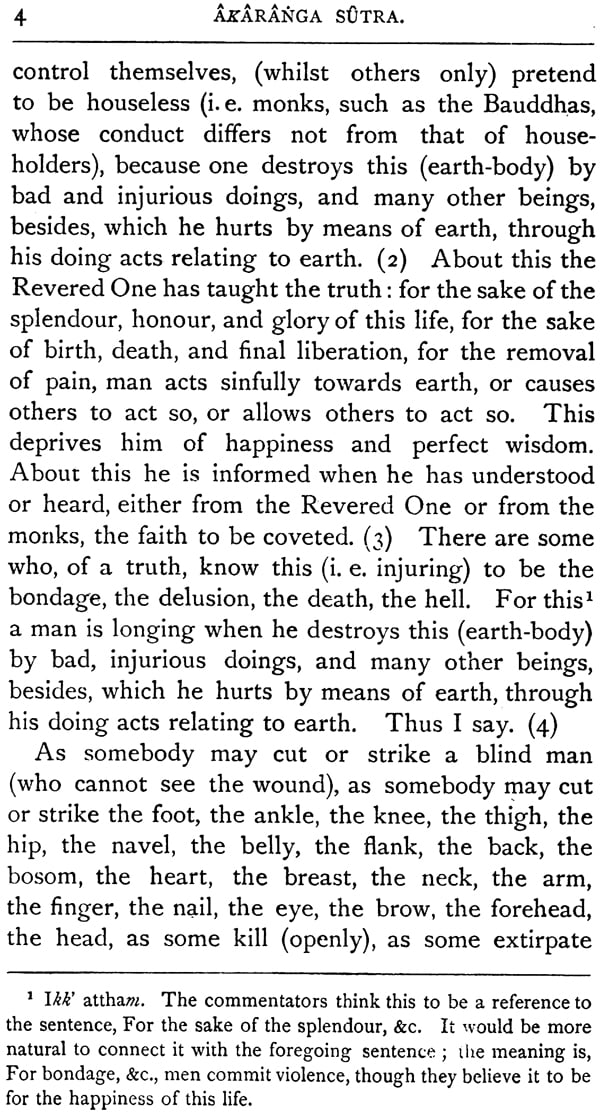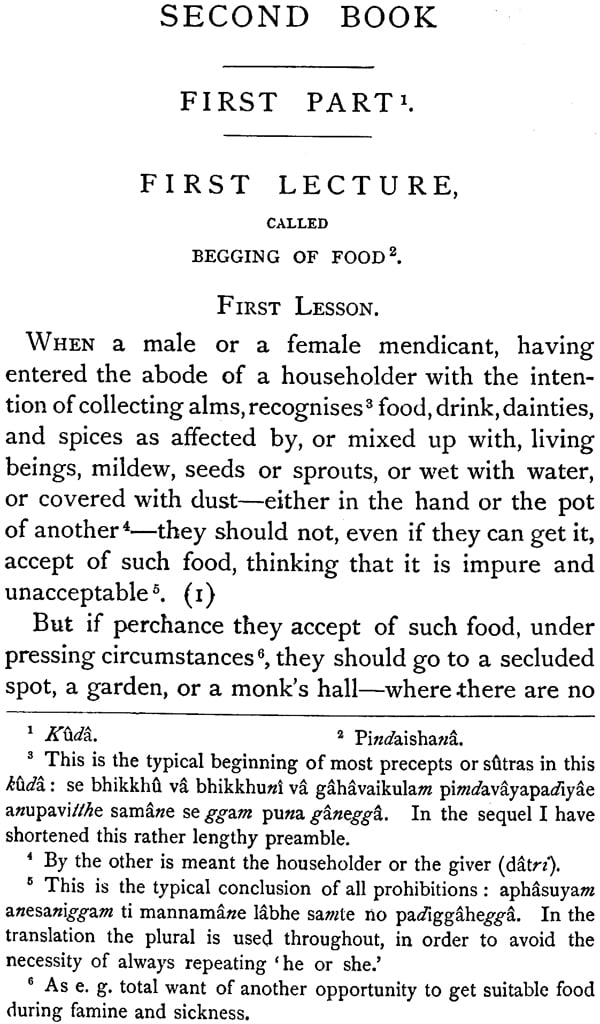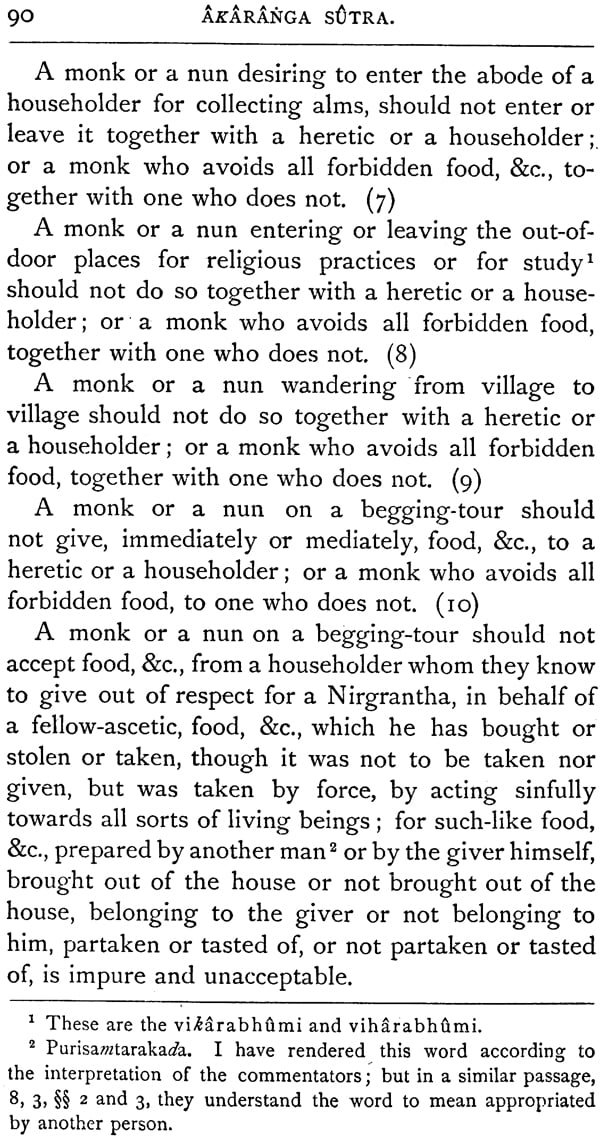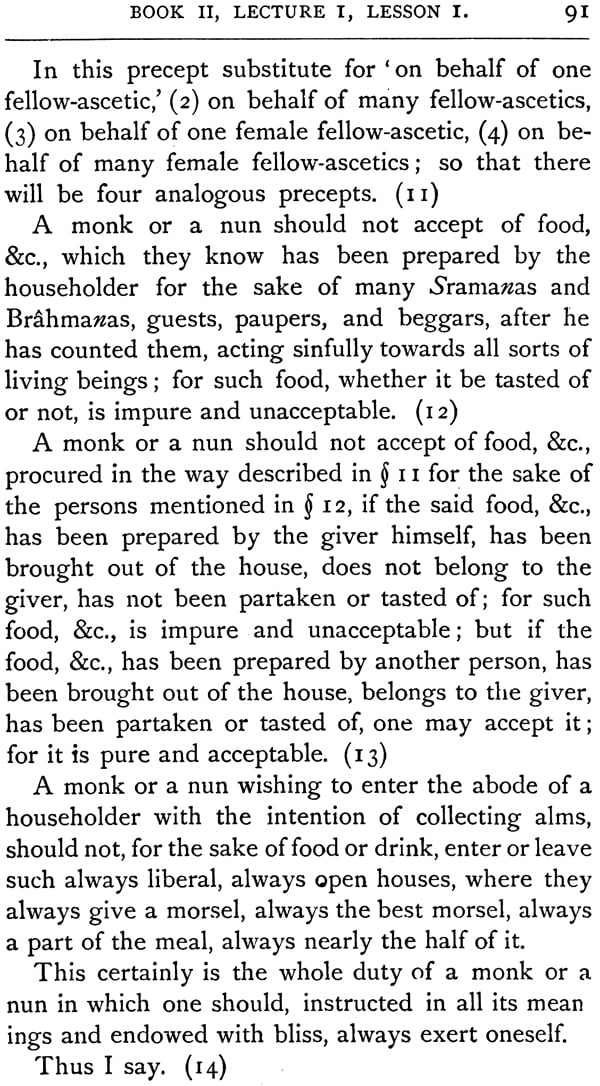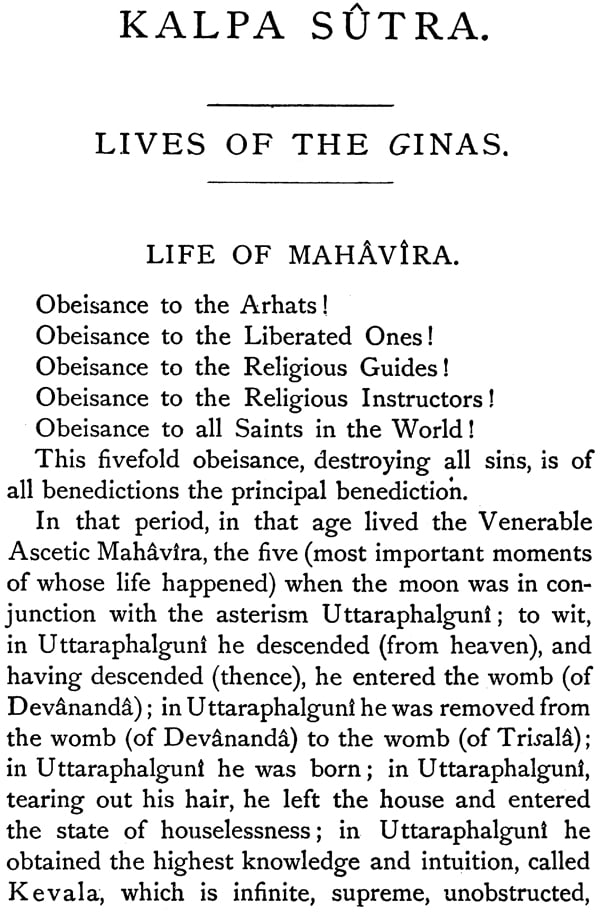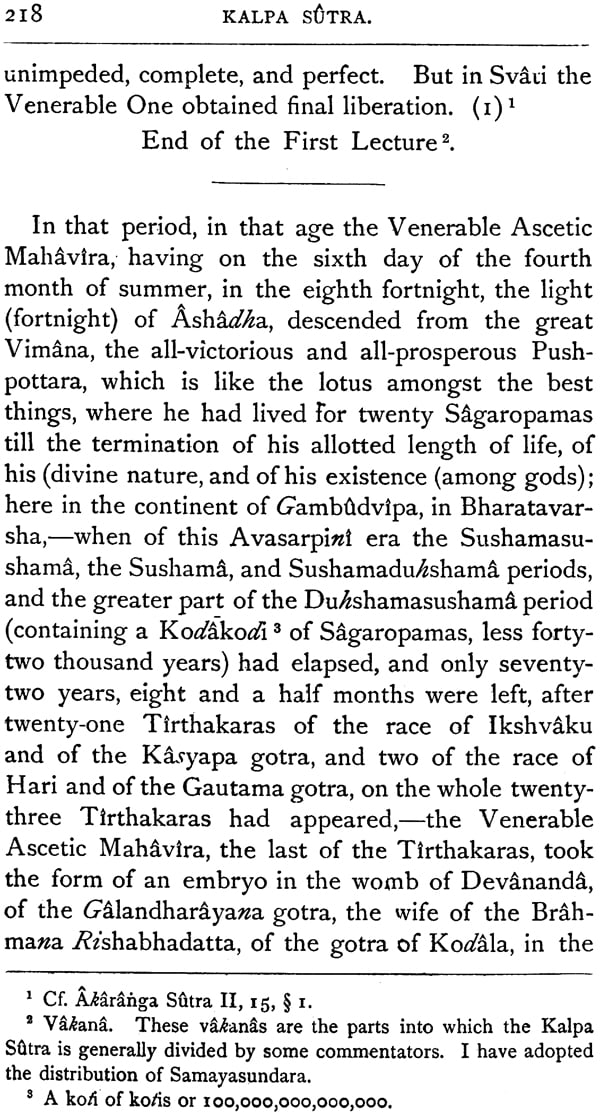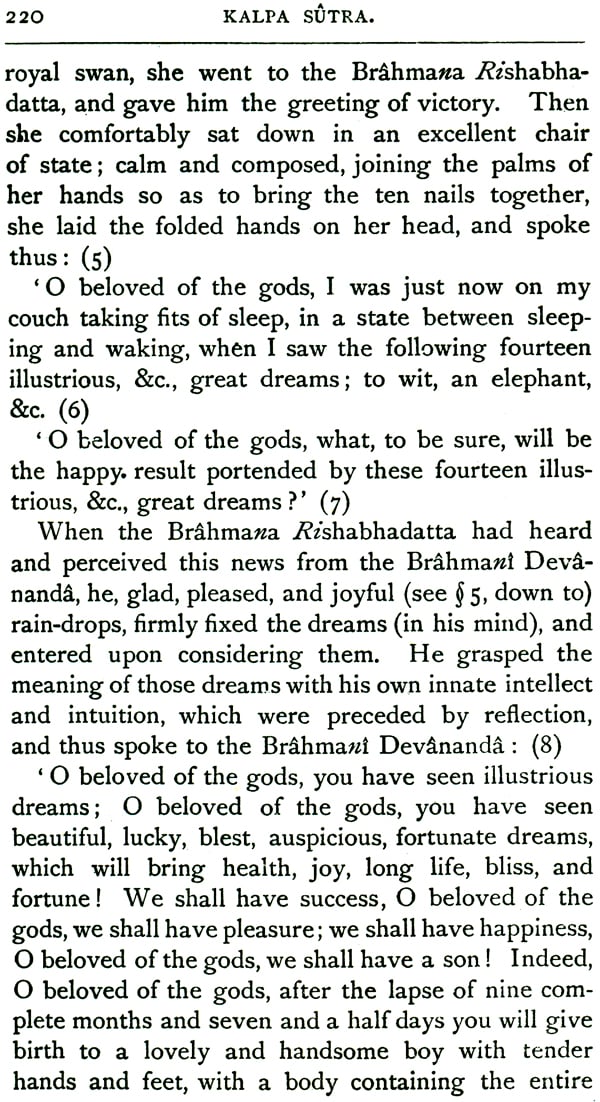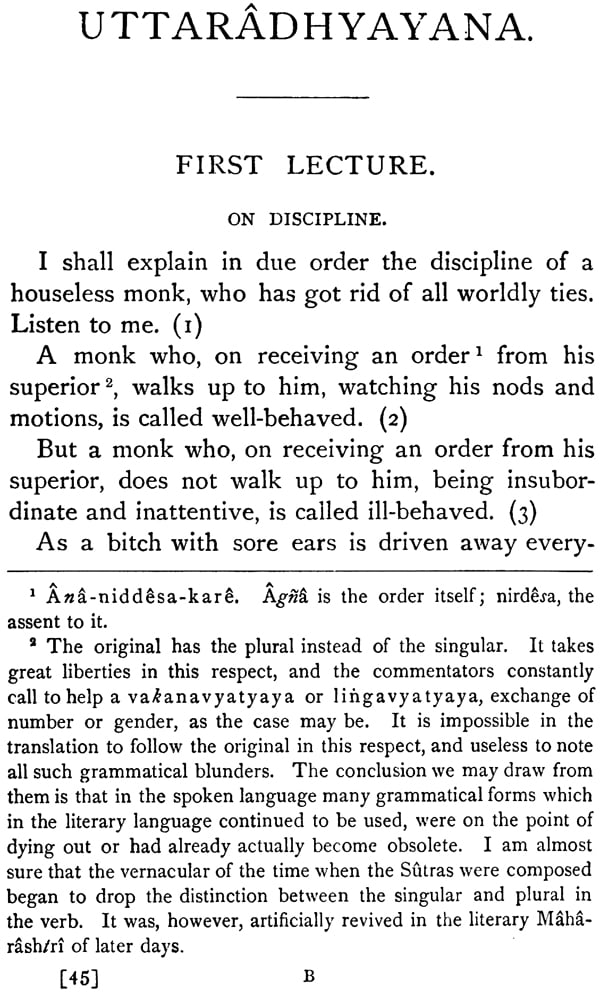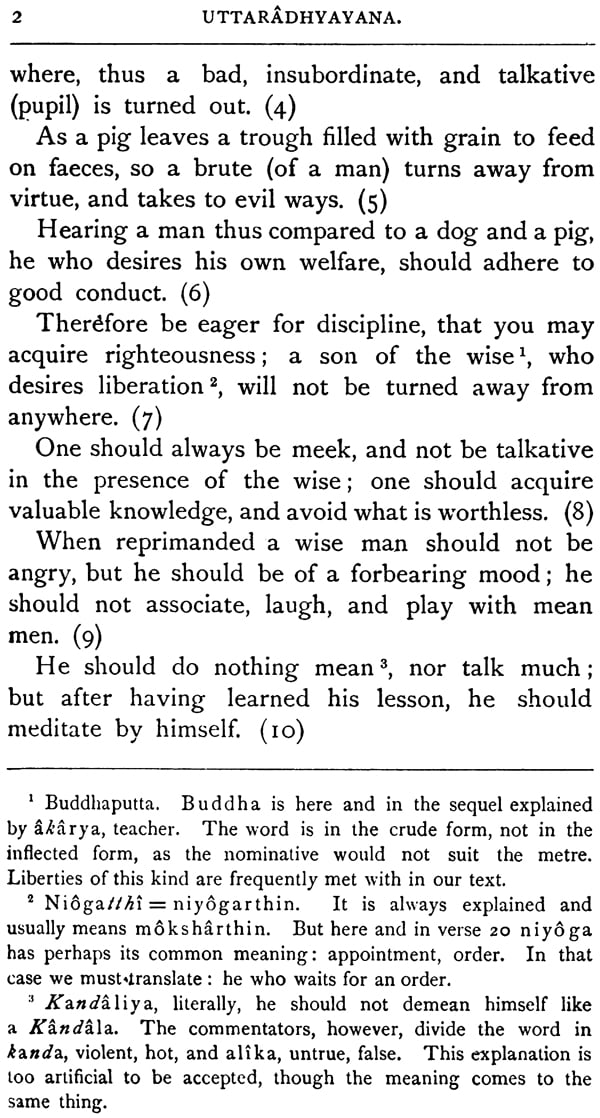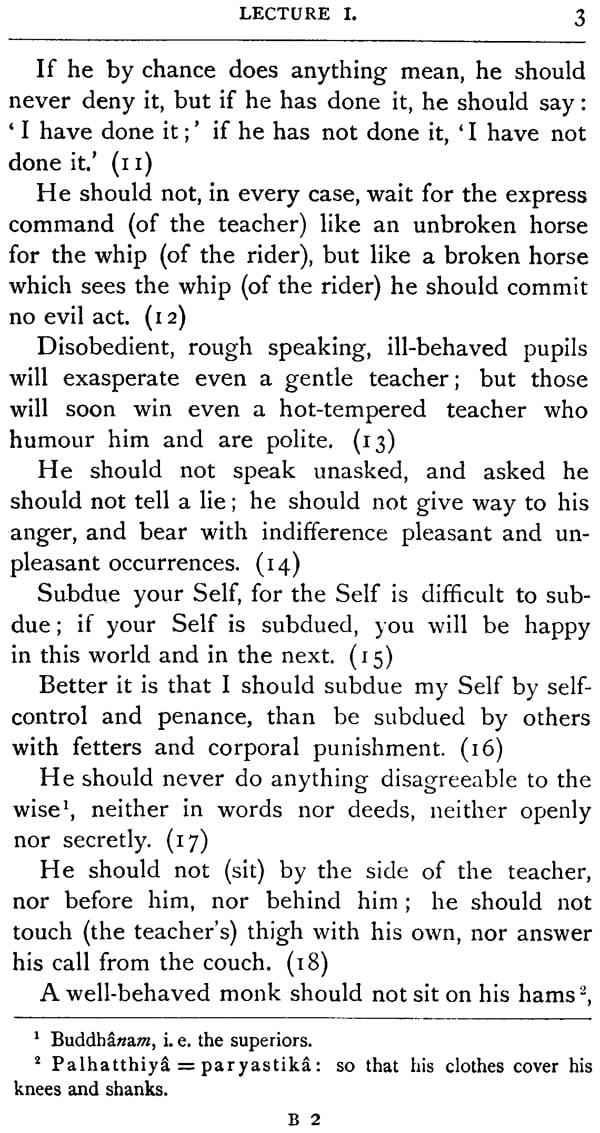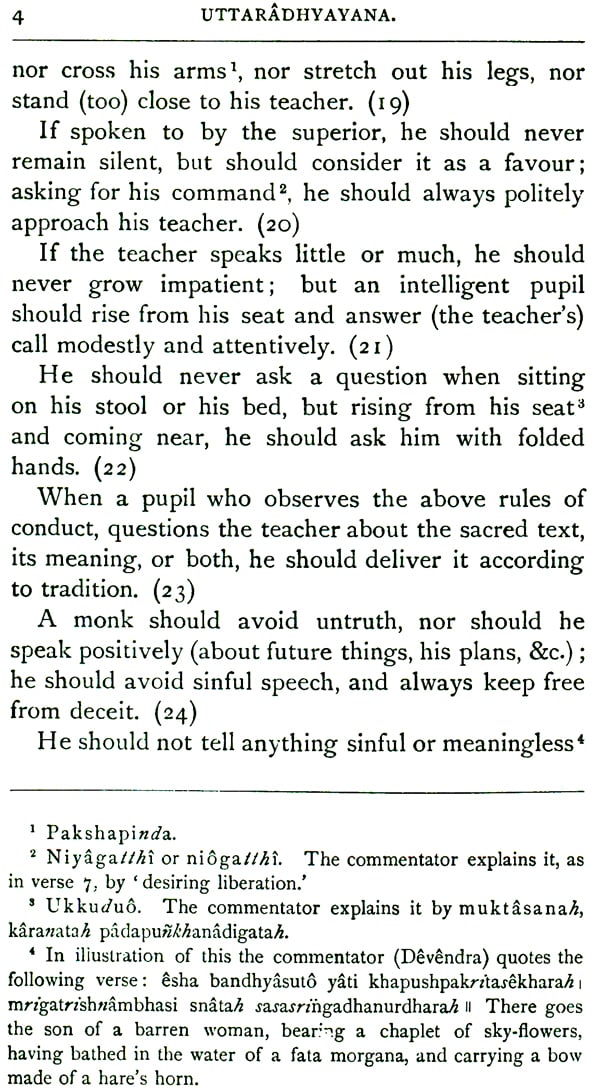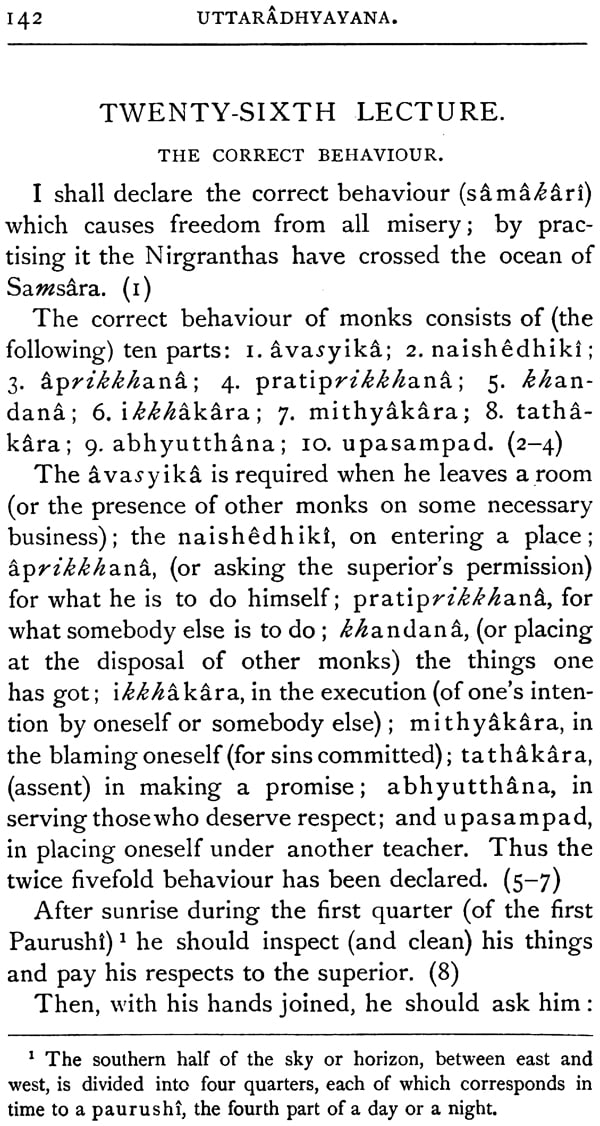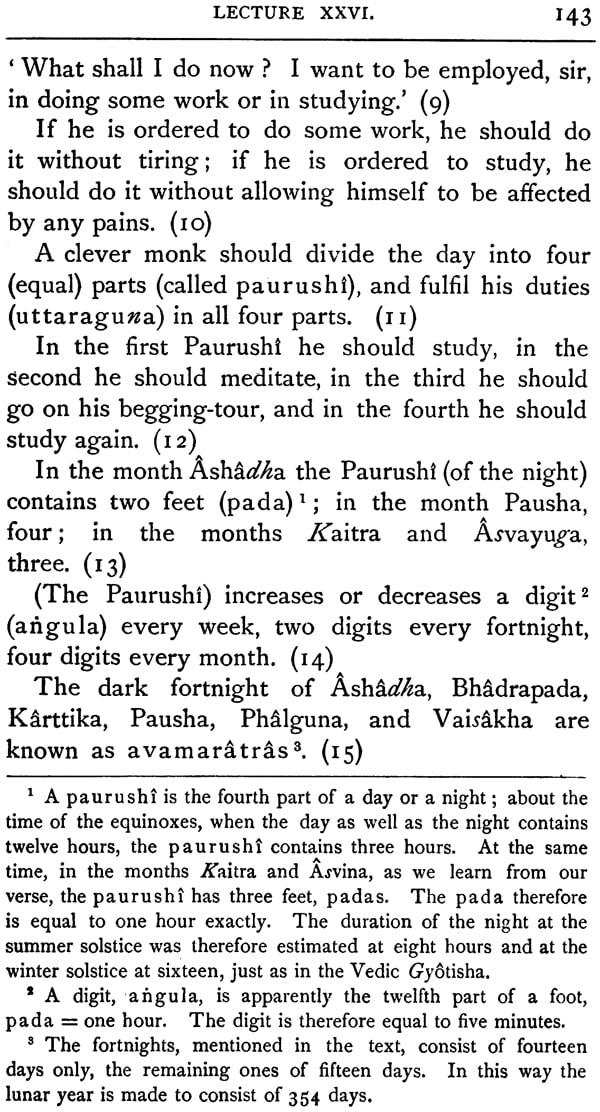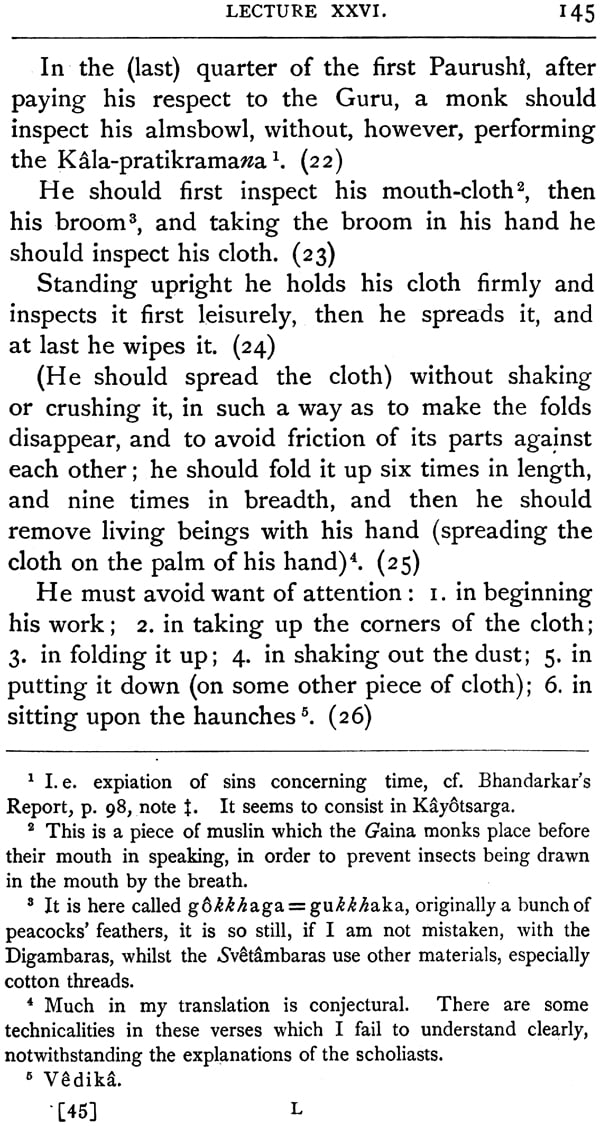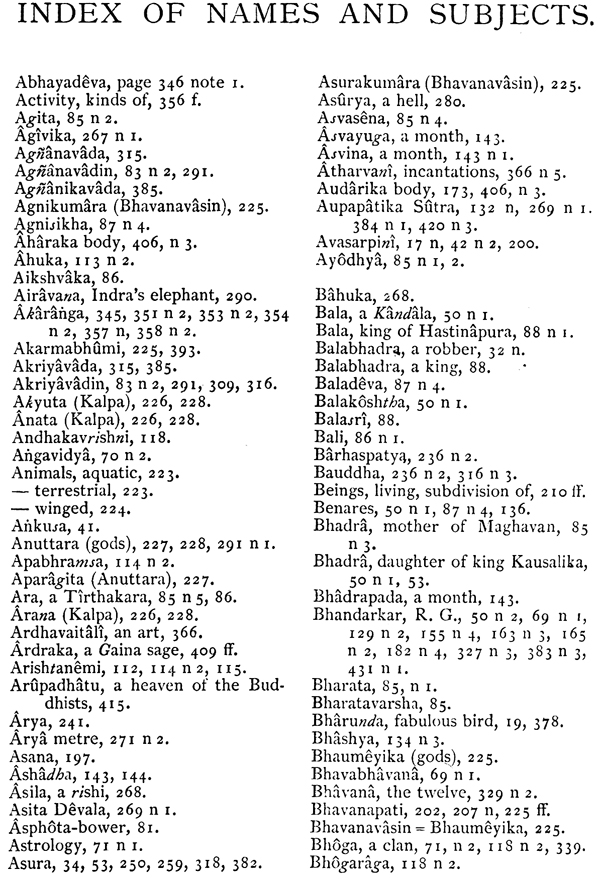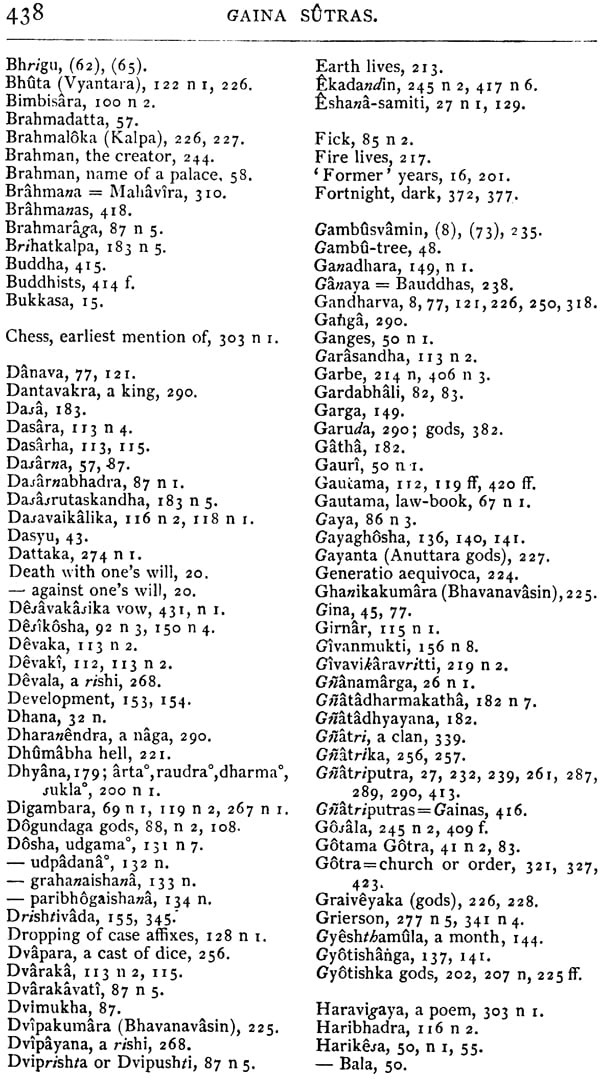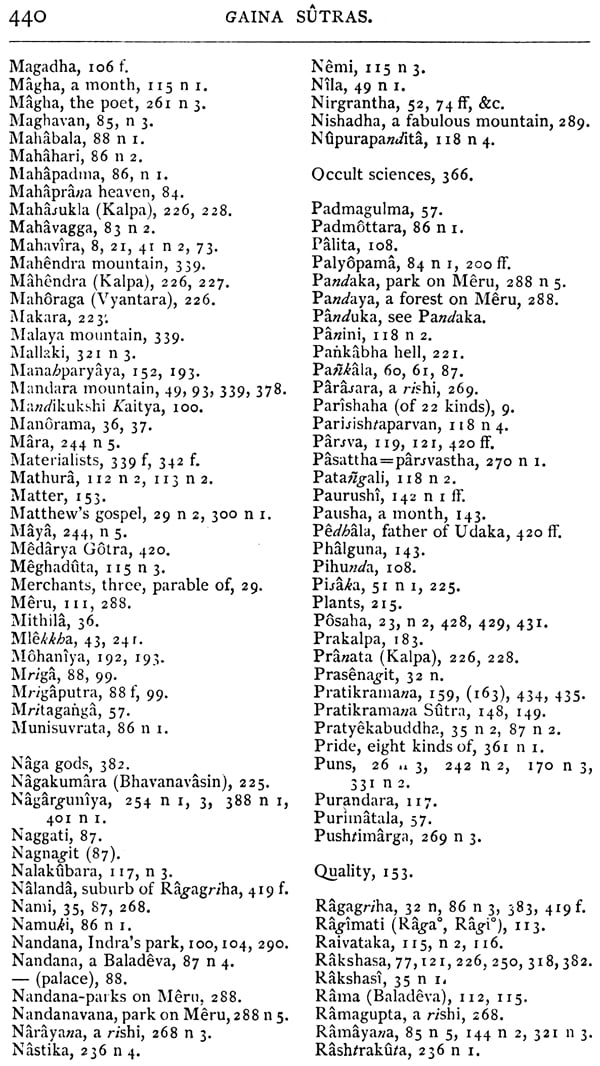
Jaina Sutras (Set of Two Volumes)
Book Specification
| Item Code: | NAM243 |
| Author: | Hermann Jacobi |
| Publisher: | MOTILAL BANARSIDASS PUBLISHERS PVT. LTD. |
| Language: | English |
| Edition: | 2010 |
| ISBN: | Vol. 1: 9788120801233 Vol.2: 9788120801462 |
| Pages: | 875 |
| Cover: | Hardcover |
| Other Details | 9.0 inch X 6.0 inch |
| Weight | 1.30 kg |
Book Description
Volume-I
Introduction
The origin and development of the Gaina sect is a subject on which some scholars still think it safe to speak with a sceptical caution, though this seems little warranted by the present state of the whole question; for a large and ancient literature has been made accessible, and furnishes ample materials for the early history of the sect to all who are willing to collect them. Nor is the nature of these materials such as to make us distrust them. We know that the sacred books of the Gainas are old, avowedly older than the Sanskrit literature which we are accustomed to call classical. Regarding their antiquity, many of those books can vie with the oldest books of the northern Buddhists. As the latter works have successfully been used as materials for the history of Buddha and Buddhism, we can find no reason why we should distrust the sacred books of the Gainas as an authentic source of their history. If they were full of contradictory statements, or the dates contained in them would lead to contradictory conclusions, we should be justified in viewing all theories based on such materials with suspicion. But the character of the Gaina literature differs little in this respect also from the Buddhistical, at least from that of the northern Buddhists. How is it then that so many writers are inclined to accord a different age and origin to the Gaina sect from what can be deduced from their own literature? The obvious reason is the similarity, real or apparent, which European scholars have discovered between Gainism and Buddhism. Two sects which have so much in common could not, it was thought, have been independent from each other, but one sect must needs have grown out of, or branched off from the other. This a priori opinion has prejudiced the discernment of many critics, and still does so. In the following pages I shall by to destroy this prejudice, and to vindicate that authority and credit of the sacred books of the Gainas to which they are entitled. We begin our discussion with an inquiry about Mahavira, the founder or, at least, the last prophet of the Gaina church. It will be seen that enough is known of him to invalidate the suspicion that he is a sort of mystical person, invented or set up by a' younger sect some centuries after the pretended age of their assumed founder.
The Gainas, both Svetambaras and Digambaras, state that Mahavira was the son of king Siddhartha of Kundapura or Kundagrama. They would have us believe that Kundagrama was a large town, and Siddhartha a powerful monarch. But they have misrepresented the matter in overrating the real state of things, just as the Buddhists did with regard to Kapilavastu and Suddhodana. For Kundagrama is called in the Akaranga Sutra a samnivesa, a term which the commentator interprets as denoting a halting-place of caravans or processions. It must therefore have been an insignificant place, of which tradition has only recorded that it lay in Videha (Akaranga Sutra Il, 15, & 17). Yet by combining occasional hints in the Bauddha and Gaina scriptures we can, with sufficient accuracy, point out where the birthplace of Mahavira was situated; for in the Mahavagga of the Buddhists 1 we read that Buddha, while sojourning at Kotiggama, was visited by the courtezan Arnbapali and the Likkhavis of the neighbouring capital Vesali, From Kotiggama he went to where the Natikas (lived). There he lodged in the Natika Brickhall, in the neighbourhood of which place the courtesanAmbapali possessed a park, Ambapalivana, which she bequeathed on Buddha and the community. From there he went to Vesali, where he converted the general-in-chief (of the Likkhavis), a lay-disciple of the Nirgranthas (or Gaina monks). Now it is highly probable that the Kotiggama of the Buddhists is identical with the Kundaggama of the Gainas. Apart from the similarity of the names, the mentioning of the Natikas, apparently identical with the Gnatrika Kshatriyas to whose clan Mahavira belonged, and of Siha, the Gaina, point to the same direction. Kundagrama, therefore, was probably one of the suburbs of Vaisali, the capital of Videha. This conjecture is borne out by the name Vesalie, i. e. Vaisalika given to Mahavira in the Sutrakritanga I,3. The commentator explains the passage in question in two different ways, and at another place a third explanation is given. This inconsistency of opinion proves that there was no distinct tradition as to the real meaning of Vaisalika, and so we are justified in entirely ignoring the artificial explanations of the later Gainas. Vaisalika apparently means a native of Vaisali : and Mahavira could rightly be called that when Kundagrama was a suburb of Vaisali; just as a native of Turnham Green may be called a Londoner. If then Kundagrama was scarcely more than an outlying village of Vaisali, it is evident that the sovereign of that village could at best have been only a petty chief. Indeed, though the Gainas fondly imagine Siddhartha to have been a powerful monarch and depict his royal state in glowing, but typical colours, yet their statements, if stripped of all rhetorical ornaments, bring out the fact that Siddhartha was but a baron; for he is frequently called merely Kshatriya - his wife Trisala is, so far as I remember, never styled Devi, queen, but always Kshatriyani. Whenever the Gnatrika Kshatriyas are mentioned, they are never spoken of as Siddhartha's Samantas or dependents, but are treated as his equals. From all this it appears that Siddhartha was no king, nor even the head of his clan, but in all probability only exercised the degree of authority which in the East usually falls to the share of landowners, especially of those belonging to the recognised aristocracy of the country. Still he may have enjoyed a greater influence than many of his fellow-chiefs; for he is recorded to have been highly connected by marriage. His wife Trisala was sister to Ketaka, king. of Vaisali '. She is called Vaidehi or Videhadatta , because she belonged to the reigning line of Videha.
Buddhist works do not mention, for aught I know, Ketaka, king of Vaisali ; but they tell us that the government of Vesali was vested in a senate composed of the nobility and presided over by a king, who shared the power with a viceroy and a general-in-chief ". In Gaina books we still have traces of this curious government of the Likkhavis; for in the Nirayavali Sutra it is related that king Ketaka, whom Kunika, al. Agatasatru, king of Kampa, prepared to attack with a strong army, called together the eighteen confederate kings of Kasi and Kosala, the Likkhavis and Mallakis, and asked them whether they would satisfy Kunika's demands or go to war with him. Again, on the death of Mahavira the eighteen confederate kings, mentioned above, instituted a festival to be held inmemory of that event, but no separate mention is made of Ketaka, their pretended sovereign. It is therefore probable that Ketaka was simply one of these confederate kings and of equal power with them. In addition to this, his power was checked by the constitution of Vesali, So we are enabled to understand why the Buddhists took no notice of him, as his influence was not very great, and, besides, was used in the interest of their rivals. But the Gainas cherished the memory of the maternal uncle and patron of their prophet, to whose influence we must attribute the fact, that Vairali used to be a stronghold of Gainism, while being looked upon by the Buddhists as a seminary of heresies and dissent.
Contents
| Introduction | ix | |
| Akaranga Sutra | ||
| First Book | ||
| Lecture 1 | Knowledge of the Weapon | 1 |
| Lecture 2 | Conquest of the World | 15 |
| Lecture 3 | Hot and Cold | 28 |
| Lecture 4 | Righteousness | 36 |
| Lecture 5 | Essence of the World | 42 |
| Lecture 6 | Cleaning | 53 |
| Lecture 7 | Liberation | 62 |
| Lecture 8 | The Pillow of Righteousness | 79 |
| Second Book | ||
| First Part | ||
| Lecture 1 | Begging of Food | 88 |
| Lecture 2 | Begging for a Couch | 120 |
| Lecture 3 | Walking | 136 |
| Lecture 4 | Modes of Speech | 149 |
| Lecture 5 | Beggihg of CIothes | 157 |
| Lecture 6 | Begging for a Bowl | 166 |
| Lecture 7 | Regulation of Possession | 171 |
| Second Part | ||
| Lecture 8 | 178 | |
| Lecture 9 | 179 | |
| Lecture 10 | 180 | |
| Lecture 11 | 183 | |
| Lecture 12 | 185 | |
| Lecture 13 | 186 | |
| Lecture 14 | 188 | |
| Third Part | ||
| Lecture 15 | The Clauses | 189 |
| Fourth Part | ||
| Lecture 16 | The Liberation | 211 |
| Kalpa Sutra | ||
| Lives of the Ginas | 217-285 | |
| Life of Mahavira | 217-270 | |
| Lecture 1 | 217 | |
| Lecture 2 | 218 | |
| Lecture 3 | 229 | |
| Lecture 4 | 238 | |
| Lecture 5 | 251 | |
| Life of Parsva | 271-275 | |
| Life of Arishtanemi | 276-279 | |
| Epochs of the intermediate Tfrthakaras | 280 | |
| Life of Rishabha | 281-285 | |
| List of the Sthaviras | 286-295 | |
| Rules for Yatis | 296-311 | |
| Index | 313-320 | |
| Transliteration of Oriental Alphabets adopted for the Translations of the Sacred Books of the East | 321-324 |
Volume-II
Introduction
Ten years have elapsed since the first part of my translation of Gaina Sutras appeared. During that decennium many and very important additions to our knowledge of Gainism and its history have been made by a small number of excellent scholars. The text of the canonical books, together with good commentaries in Sanskrit and Guzerati, has been made accessible in fair editions published by native scholars in India. Critical editions of two of them have been published by Professors Leumann and Hoernle and the latter scholar has added a careful translation and ample illustrations to his edition of the text. A general survey of the whole Gaina literature has been given by Professor Weber in his catalogue of the Berlin Manuscripts and in his learned treatise on the sacred literature of the Gainas. The development of Gaina learning and science has been studied by Professor Leumann, and some Gaina legends and their relations to those of the Brahmans and Buddhists have been investigated by the same scholar. An important document for our knowledge of the old history of the Svetarnbara sect has been edited by myself, and the history of some of their Gakkhas has been made known from their lists of teachers by Hoernle and Klatt. The last-named scholar, whom we have all but lost by this time, has prepared a biographical dictionary of all Gaina writers and historical persons, and he has issued specimens of this great Onomasticon, while Hofrat Buhler has written a detailed biography of the famous encyclopaedist Hernakandra. The same scholar has deciphered the ancient inscriptions, and discussed the sculptures excavated by Dr. Fuhrer at Mathura, and the important inscriptions at Sravana Belgola have been edited by Mr. Lewis Rice ; M. A. Barth has reviewed our knowledge of Gainism, and likewise Buhler in a short paper. Lastly Bhandarkar has given a most valuable sketch of the whole of Gainism. All these additions to our knowledge of Gainism (and I have but mentioned the most remarkable ones) have shed so much clear light on the whole subject that little room is left now for mere guesswork, and the true historical and philological method can be applied to all its parts. Still some of the principal problems require elucidation, while the proffered solution of others is not accepted by all scholars. I, therefore, gladly avail myself of this opportunity to discuss some of the disputed points, for the settling of which the works translated in this volume offer valuable materials.
It is now admitted by all that Nataputta (Gnatriputra), who is commonly called Mahavira or Vardhamana, was a contemporary of Buddha; and that the Niganthas 8(Nirgranthas), now better known under the name of Gainas or Arhatas, already existed as an important sect at the time when the Buddhist church was being founded. But it is still open to doubt whether the religion of the early Nirgranthas was essentially the same as that taught in the canonical and other books of the present Gainas, or underwent a great change up to the time of the composition of the Siddhanta. In order to come nearer the solution of this question, it may be desirable to collect from the published Buddhist works, as the oldest witnesses we can summon, all available information about the Niga1ttltas, their doctrines and religious practices.
In the Anguttara Nikaya, III, 74, a learned prince of the Likkhavis of Vaisali, Abhaya gives the following account of some Nigantha doctrines: 'The Nigantha Nataputta, sir, who knows and sees all things, who claims perfect knowledge and faith (in the following terms): "walking and standing, sleeping or waking, I am always possessed of perfect knowledge and faith;" teaches the annihilation by austerities of the old Karman, and the prevention by in activity of new Karman. When Karman ceases, misery ceases; when misery ceases, perception ceases ; when perception ceases, every misery will come to an end. In this way a man is saved by pure annihilation of sin (niggara) which is really effective.
The Gaina counterpart to these tenets can be collected from the Uttaradhyayana XXIX. ‘By austerities he cuts off Karman,' § 27. 'By renouncing activity he obtains inactivity; by ceasing to act he acquires no new Karman, and destroys the Karman he had acquired before,' § 37. The last stages in this process are fully described in §§ 71, 72. And again, in XXXII, v. 7, we read: 'Karman is the root of birth and death, and birth and death they call misery.' The nearly identical verses 34,47,60, 73, 86, 99 may be thus condensed: 'But a man who is indifferent to the object of the senses, and to the feelings of the mind [this comes nearest to the Buddhist vedana, perception], is free from sorrows; though still in the Samsara, he is not afflicted by that long succession of pains just as the leaf of the Lotus (is not, moistened) by water.'
The above assertion that Nataputta claimed the possession of perfect knowledge and faith, requires no further proof; for it is one of the fundamental dogmas of the Gainas.
Another piece of information about Nigantha doctrines may be gathered from the Mahavagga VI, 3 (S. B. E., vol. xvii, p. 108 ff.) There a story is told of Siha, the general of the Likkhavis, who was a lay disciple of Nataputta. He wanted to pay the Buddha a visit, but Nataputta tried to dissuade him from it, because the Niganthas held the Kriyavada, while the Buddha taught the Akriyavada, Siha, however, setting his master's prohibition at nought, went to the Buddha on his own account, and was, of course, converted by him. Now the statement that the Niganthas embraced the Kriyavada is borne out by our texts; for in the Sutrakritanga I, 12, 21, below, p. 319, it is said that a perfect ascetic' is entitled to expound the Kriyavada ;' and this doctrine is thus expressed in the Akaranga Sutra I, I, 1, 4 (part i, p. 2): 'He believes in soul, believes in the world, believes in reward, believes in action (believed to be our own doing in such judgments as these): "I did it;" "I shall cause another to do it;" " I shall allow another to do it." ,
Another lay disciple of Mahavira, converted by the Buddha, was Upali. As narrated in the Magglzima Nikaya 56, he ventured upon a dispute with him whether the sins of the mind are heaviest. as the Buddha teaches. or the sins of the body, as the Nigantha Nataputta contends. In the beginning of the discourse Upali states that his master uses the term danda, punishment, for what is commonly called kamma, deed, act. This is true, though not quite to the letter; for the word kamma occurs also in the Gaina Sutras in that sense. The term danda, however, is at least as frequently used. Thus, in the Sutrakritanga II, 2, p. 357 ff., the thirteen kinds of 'committing sins' are treated of, and in the first five cases the word which I have translated 'committing sins' is in the original dandasamadane, and in the remaining cases kiriyathan e, i. e. kriyasthana.
| Introduction | xiii | |
| Uttaradhyayana | ||
| Lecture 1 | On discipline (especially for pupils) | 1 |
| Lecture 2 | On troubles. (About the twenty-two things that cause trouble to monks) | 8 |
| Lecture 3 | The four requisites (for the attainment of beatitude) | 15 |
| Lecture 4 | Impurity. (Carefulness required for obtaining the end). | 18 |
| Lecture 5 | Death against (and with) one's will | 20 |
| Lecture 6 | The false ascetic. (Wrong conduct leads to perdition, right conduct to salvation) | 24 |
| Lecture 7 | The parable of the ram, &c. (illustrative of the folly of the sinner who misses his chance of reaching a more exalted state of existence) | 27 |
| Lecture 8 | Kapila's verses (in praise of good conduct) | 31 |
| Lecture 9 | The Pravragya of king Nami. (A dialogue between him and Indra who advised him to retain the royalty) | 35 |
| Lecture 10 | The leaf of the tree. (A sermon by Mahavira on the punishment of the sinner and the reward of the righteous) | 41 |
| Lecture 11 | The very learned (monk; his virtues and his superiority) | 46 |
| Lecture 12 | Harikera, (a Kandala, turned monk; his victory over a Brahman, whom he converts) | 50 |
| Lecture 13 | Kitra and SambhUta. (A dialogue on the vanity of worldly pleasures) | 56 |
| Lecture 14 | Ishukdra. (A legend, illustrating the excellence of a monastic life) | 61 |
| Lecture 15 | The true monk; (how he should conduct himself) | 69 |
| Lecture 16 | The ten conditions of perfect chastity | 73 |
| Lecture 17 | The bad Sramana; (what a monk should avoid) | 77 |
| Lecture 18 | Sangaya. (King S. turned monk; he preaches that the state of a monk is preferable to that of a king; illustrations from Gaina history) | 80 |
| Lecture 19 | The son of Mriga. (On the punishment in the hells) | 88 |
| Lecture 20 | The great duty of the Nirgranthas. (A dialogue between king Srenika and a monk on the happiness obtained by righteousness. The bad monk is lost) | 100 |
| Lecture 21 | Samudrapala, (turned monk. On the duties of a monk) | 108 |
| Lecture 22 | Rathanerni. (The renunciation of Arishtranemi, his wife Ragimati exhorts Rathanerni) | 112 |
| Lecture 23 | Kesi and Gautama. (The followers of Parrva are brought over to the church of Mahavira) | 119 |
| Lecture 24 | The Samitis (and the Guptis) | 129 |
| Lecture 25 | The true sacrifice. (GayaghOsha, the monk, converts Vigayaghosha, the Brahman) | 136 |
| Lecture 26 | The correct behaviour (of monks during the several parts of day and night) | 142 |
| Lecture 27 | The bad bullocks (compared to bad pupils by Garga) | 149 |
| Lecture 28 | The road to final deliverance. (On the fundamental principles of Gainism) | 152 |
| Lecture 29 | The exertion in righteousness. (On the seventy-three articles necessary for reaching perfection) | 158 |
| Lecture 30 | The road of penance. (On external and internal austerities) | 174 |
| Lecture 31 | Mode of life. (A list of articles of the Gaina faith according to the number of their subdivisions) | 180 |
| Lecture 32 | The causes of carelessness; (what excites the passions and produces Karman) | 184 |
| Lecture 33 | The nature of Karman, (and the subdivisions of it) | 192 |
| Lecture 34 | On Lesya | 196 |
| Lecture 35 | The houseless monk. (The cheif duties of a monk) | 203 |
| Lecture 36 | On living beings and things without life. (The contents of this Lecture are detailed in note 2, pp. 206, 207) | 206 |
| Sutrakritanga | ||
| First Book | ||
| Lecture 1 | The doctrine. (On some heretical doctrines) | 235-248 |
| (Materialists, v. 8; Vedantins, v. 9; other materialists, vv. I I, 12; Akriyavdins, v. 13; forerunners of the Vaiseshikas.v. 15; Bauddhas, v. 17; Ganayas, v, 18) | 235 | |
| (Fatalists, vv. 1-3; Agnostics, v. I7; Kriyavadins, v. 24; Buddhists, vv. 25-28, cf. p. 414) | 239 | |
| (Pauranikas, vv. 6-8; the followers of Gosala, vv. r r , 12; Vainayikas, v. 14) | 243 | |
| (Some popular beliefs, vv. 6, 7 Conclusion) | 246 | |
| Lecture 2 | The destruction of Karrnan ; (how to lead a holy life) | 249-261 |
| Chapter 1 | 249 | |
| Chapter 2 | 253 | |
| Chapter 3 | 257 | |
| Lecture 3 | The knowledge of troubles | 261-271 |
| Chapter 1 | (A monk encounters many difficulties) . | 261 |
| Chapter 2 | (He is tempted back to domestic life) | 263 |
| Chapter 3 | (He easily desponds. The opinion refuted that a monk should not provide a sick brother with food) | 265 |
| Lecture 3 | Chapter 4. (Several objections removed) | 268 |
| Lecture 4 | Knowledge of women | 271-278 |
| Chapter 1. | (How women tempt a monk) | 271 |
| Chapter 2. | (How they treat him afterwards) | 275 |
| Lecture 5 | Description of the hells . | 279-286 |
| Chapter 1. | 279 | |
| Chapter 2. | 283 | |
| Lecture 6 | Praise of Mahavira | 287 |
| Lecture 7 | Description of the wicked. (No living beings should be destroyed; no merit in ablutions and tending the sacrificial fire. A monk should not be selfish) | 292 |
| Lecture 8 | On exertion. (Exertion not leading to works recommended) | 297 |
| Lecture 9 | The Law. (What a monk should abstain from) | 301 |
| Lecture 10 | Carefulness. (Some more injunctions and prohibitions) | 306 |
| Lecture 11 | The Path. (The same subject continued and concluded) | 310 |
| Lecture 12 | The creed. (On the four heresies: Agnosticism, v. 2; Vinayavdda, v. 3 ; Akriyavdda, vv. 4-10; Kriyavada, v. I I ff.) | 315 |
| Lecture 13 | The real truth. (Some duties of a pious monk) | 320 |
| Lecture 14 | The Nirgrantha. (The same subject continued) | 324 |
| Lecture 15 | The Yamakas. (Miscellaneous topics treated in artificial verses) | 329 |
| Lecture 16 | The song. (On the virtues of a true monk) | 333 |
| Second Book | ||
| Lecture 1 | The Lotus. (The parable of the Lotus. The Materialists, § 14 ff. Another school of Materialists and the forerunners of the Vaiseshikas, § 20 ff. The Vedintins, § 25 ff. The fatalists, § 30 ff. Exhortation to follow the true Law, § 35 ff.) | 335 |
| On activity. (The twelve kinds of committing sin, and sinless actions. Some wicked practices described, § 25 ff. Some more wicked practices, § 60 ff. Right conduct of monks, § 69 ff.; of laymen, § 75 ff. Re- futation of the 363 heretical philosophical sch | 355 | |
| Knowledge of food. (On the generation of living beings) . | 388 | |
| Renunciation of activity. (An action is sinful though it be done unconsciously) | 398 | |
| Freedom from error; (what should be maintained and what not) | 405 | |
| Ardraka; (his dispute with Gosala, a Buddhist, a Vedic priest, a Vedantin, and a Hastitapasa) | 409 | |
| Nalanda. (Udaka, a follower of Parsva, is converted by Gautama) | 419 | |
| Index of Names and Subjects | 437 | |
| Index of Sanskrit and Prakrit Words | 443 | |
| Transliteration of Oriental Alphabets adopted for the Translations of the Sacred Books of the East | 453 |
